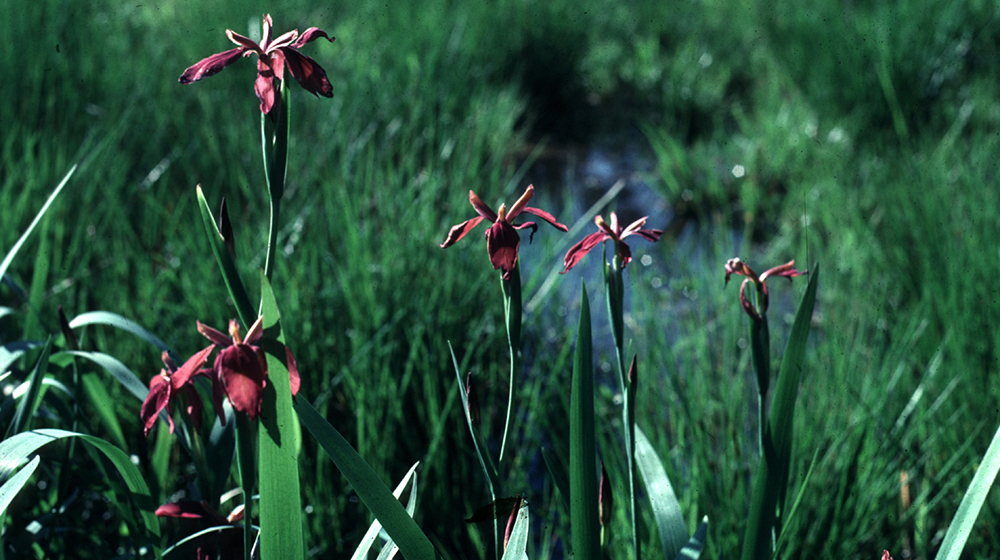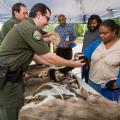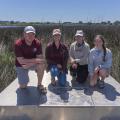Louisiana Iris in the Home Landscape

Louisiana iris has the distinction of having the greatest diversity of colors out of any iris group. Virtually every color of the rainbow is found in the flowers of these iris species. This is fortunate, as the name iris is derived from the Greek word meaning rainbow.
Early French explorers to the Gulf of Mexico called the Louisiana iris "les glis de marais" or "glads of the marsh." The broad color range has made the Louisiana's one of the most popular irises in the world. They can be found growing in the gardens of England, Australia, South Africa and New Zealand. Louisiana iris typically bloom from late March to early May in Mississippi.
Louisiana Iris Types
The Louisiana iris group (known as the hexagonae series) is composed of five distinct species: Iris fulva, I. brevicaulis, I. nelsonii, I. hexagona, and I. giganticaerulea. These species are found in different geographic locations because of slightly different environmental preferences. These include light intensity, soil types and pH (degree of acidity or alkalinity), and water salinity (degree of salt).
Copper iris (Iris fulva) has small rusty red-to-scarlet flowers that reach two-to-three feet in height. Found in sunny swamps, streams, and roadside ditches, copper iris is intolerant of shade or saltwater. Iris brevicaulis is a smaller plant that grows to sixteen inches in height. This iris is better adapted to drier conditions and can be found in pastures, on stream banks, and near bluffs. The flowers are medium sized and range from lavender to white. Giant blue flag iris, or Iris giganticaerulea, can reach six feet in height and has flowers ranging in color from pure white to deep velvety blues. Giant blue flag is found along the coast in sunny marshes and swamps. Iris hexagona closely resembles I. giganticaerulea, yet tend to have purple flowers trimmed with yellow. Iris nelsonii has a broad color range that allows it to be easily hybridized. This vigorous species was once known as the 'Abbeville Reds' because they were native only to Abbeville, Louisiana. The flowers are large, and colors include reds, yellows, browns, and purples.
How to Grow
Louisiana iris are very easy to grow. They thrive in ditches, bogs, along pond edges, or in garden beds that stay moist and fertile. When planting in water, place the root ball no deeper than six inches below the water surface. Louisiana iris grows actively in the winter months until flowering, then goes into a state of dormancy in the summer as the heat arrives. It is normal during the summer dormant period for the leaves to yellow and wither.
When growing iris in the garden, provide a thick mulch around the plants to ensure proper moisture and organic matter. The mulch also reduces the chances of sun scald on iris rhizomes (the horizontal plant stems that run along the ground). Iris need at least six hours of full sunlight in order to bloom, preferably morning sun. In soil conditions with a pH greater than 6.0, yellow leaves and poor growth can occur. Fertilize the plants periodically during the winter with an 8-8-8 liquid or slow release fertilizer.
There are few serious insect and disease problems associated with Louisiana iris. Cutworms and leaf miners may damage the leaves of the plant, but do little harm to overall plant health. Many general purpose insecticides may repel or control these insects. Iris rust is a foliar disease that causes brown spots to appear occasionally. This fungus does not harm the plant but may discolor the foliage. An excessive use of nitrogen fertilizer tends to stimulate the occurrence of iris rust.
Iris in the Landscape
The striking vertical leaves of this herbaceous perennial makes it a welcome addition to any garden bed. Because iris's bloom in Spring, combine with low growing summer and fall blooming perennials and annuals. Louisiana iris makes a great background plant for 'New Gold' lantana, verbena, pentas, coreopsis, and other flowering plants. Use Louisiana iris as accents and focal points for pond edges, stream sides, and damp areas.
Publications may download photo at 200 d.p.i.
Publications
News
An underserved community spent a day enjoying the outdoors at the Sam D. Hamilton Noxubee National Wildlife Refuge in early May as Mississippi State University Extension Service personnel hosted 20 adult residents of care homes.
Jim McAdory, MSU Extension agent in Winston County, coordinated the May 1 event with help from several other Extension agents and U.S. Fish and Wildlife Service staff. The goal was to allow this population to experience the outdoors, complete with a hot dog lunch at the end of the event.
PICAYUNE, Miss. -- School groups, nature enthusiasts and the public can enjoy two fun-filled days of exciting, hands-on learning about the environment, ecosystems, wildlife and insects at the Mississippi State University Crosby Arboretum in Picayune. BugFest offers insect-related displays, interactive exhibits, games and crafts. Biologists, naturalists, entomologists and other experts from Mississippi, Louisiana and Alabama will host booths and give presentations on butterflies, bats, caterpillars, beetles, crayfish, ladybugs, hissing cockroaches, dancing praying mantises, native and exotic arthropods and more.
Two conservation camps this summer offer students in grades six through 12 the opportunity to gain hands-on experience in wildlife science, outdoor recreation and conservation careers. Conservation Camp 2022 has a residential edition June 5-8 for rising eighth through 12th graders. The day camp edition is June 13-15 for rising sixth through eighth graders.
Success Stories
More than 80 grade-school students from Choctaw Tribal Schools visited Mississippi State University in March to participate in Choctaw Preview Day.
Robin Whitfield, who gave the child the paper, stands awestruck, watching her friend’s daughter use the flower to draw and color on the page.
Mississippi State University and partners have been awarded a grant of nearly $6.6 million from the National Fish and Wildlife Federation for shoreline restoration work on the Gulf Coast.





